
Eucalyptus eremophila, commonly known as the sand mallet or tall sand mallee, is a species of mallet that is endemic to semi-arid regions of Western Australia. It has smooth pale brown and greyish bark, narrow lance-shaped to elliptical adult leaves, flower buds arranged in groups of between seven and eleven with an elongated operculum, and cup-shaped to barrel-shaped fruit.
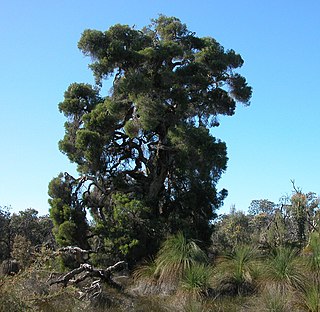
Melaleuca preissiana, commonly known as stout paperbark, modong or moonah, is a plant in the myrtle family, Myrtaceae and is endemic to coastal areas of southwest Australia. It is a shrub or small tree with papery bark, small leaves and spikes of usually white flowers. It occurs chiefly in areas that are seasonally wet.

Eucalyptus macrandra, commonly known as long-flowered marlock, river yate or twet, is a species of mallee or small tree that is endemic to the south-west of Western Australia. It has smooth greyish bark, lance-shaped adult leaves, flower buds usually in groups of fifteen, pale yellow flowers and elongated cup-shaped to bell-shaped fruits.

Eucalyptus pleurocarpa, commonly known as tallerack, talyerock or tallerack is a species of mallee that is endemic to the southwest of Western Australia. It has smooth bark, broadly lance-shaped to elliptical, grey or glaucous leaves that are arranged more or less in opposite pairs, flower buds in groups of seven, whitish flowers and glaucous, barrel-shaped fruit. It is easily recognised in the field by its form, large, white, waxy leaves and, when in flower, its stamens clustered in four groups.
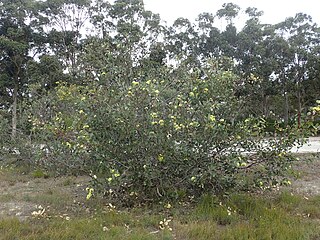
Eucalyptus preissiana, commonly known as bell-fruited mallee, is a species of small tree or shrub that occurs in an area between Albany and Esperance in Western Australia. It has a spreading habit, smooth bark, elliptical to egg-shaped or oblong leaves, flower buds in groups of three, yellow flowers and cup-shaped, conical or bell-shaped fruit.
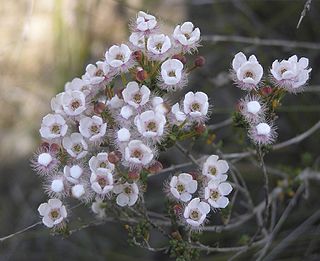
Verticordia habrantha, commonly known as hidden featherflower, is a flowering plant in the myrtle family, Myrtaceae and is endemic to the south-west of Western Australia. It is a slender shrub with short, leafy side-branches and long flowering stems with rounded heads of mostly white flowers. Its hairy sepals are mostly hidden by the round, unfringed petals, and as a result, the plant looks like shrubs in the genus Chamelaucium, to which it is closely related.

Eucalyptus foecunda, commonly known as narrow-leaved red mallee, Fremantle mallee or coastal dune mallee, is a species of plant in the myrtle family that is endemic to Western Australia. It has rough bark on the trunk, smooth bark above, narrow lance-shaped adult leaves, flower buds in groups of nine or eleven, creamy white flowers and cup-shaped fruit. It was previously included with the more widespread Eucalyptus leptophylla.
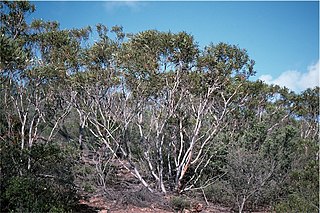
Eucalyptus lehmannii, commonly known as bushy yate, is a eucalypt in the myrtle family Myrtaceae endemic to the south-west of Western Australia. It is a small tree with an oval, spreading form and dense foliage which sometimes reaches to the ground. It is widely cultivated in Australia and the United States because of its ornamental shape and decorative flowers, buds and fruit. There has been some confusion about its classification because of its ability to hybridise.

Eucalyptus arachnaea, commonly known as the black-stemmed mallee, is a mallee or tree that is endemic to Western Australia. It has rough, stringy bark, lance-shaped leaves and white flowers in groups of up to thirteen.

Eucalyptus capillosa, commonly known as wheatbelt wandoo, or mallee wandoo, is a species of tree or mallee that is endemic to Western Australia. It has smooth, grey bark, lance-shaped to elliptic adult leaves, spindle-shaped flower buds in groups of nine to thirteen, white flowers and barrel-shaped to cylindrical fruit.
Eucalyptus crispata, commonly known as the Yandanooka mallee, is a species of tall mallee that is endemic to a small area on the east coast of Western Australia. It has a stocking of rough bark near the base of its trunk, smooth grey bark above, lance-shaped adult leaves, flower buds in groups of between nine and eleven, whitish to yellowish cream flowers and cup-shaped, barrel-shaped or hemispherical to cylindrical fruit.
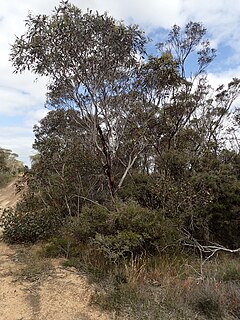
Eucalyptus hebetifolia is a species of mallee that is endemic to southern Western Australia. It has smooth grey and brownish bark with loose ribbons of bark near the base, lance-shaped adult leaves, flower buds in groups of up to thirteen, creamy white flowers and conical to barrel-shaped fruit.
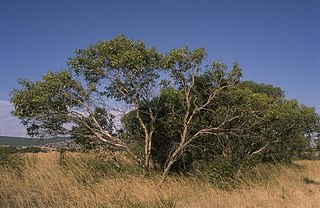
Eucalyptus incrassata, commonly known as the lerp mallee, yellow mallee, ridge fruited mallee or rib fruited mallee, is a species of mallee that is endemic to southern Australia. It has smooth bark, sometimes with rough, ribbony bark near the base, lance-shaped adult leaves, flower buds in groups of seven, creamy white, pale yellow, sometimes pink or red flowers, and cylindrical, barrel-shaped or bell-shaped fruit.

Eucalyptus luteola is a species of mallee that is endemic to a small area of Western Australia. It has smooth grey bark with rough greyish ribbons near the base, linear to narrow lance-shaped adult leaves, flower buds in groups of eleven to thirteen, lemon-coloured flowers and cylindrical to barrel-shaped fruit.
Eucalyptus spreta is a species of mallet or marlock that is endemic to the south coast of Western Australia. It has smooth bark, narrow lance-shaped to curved adult leaves, flower buds in groups of seven, white flowers and cup-shaped fruit.
Eucalyptus subangusta is a species of tree, mallee or mallet that is endemic to the southwest of Western Australia. It has smooth bark, narrow lance-shaped leaves, flower buds in groups of up to nineteen, white flowers and cup-shaped to barrel-shaped fruit.
Eucalyptus tephroclada is a species of mallee that is endemic to the southwest of Western Australia. It has smooth bark, lance-shaped adult leaves, flower buds in pendent groups of nine to thirteen, pale lemon yellow flowers and barrel-shaped to cup-shaped fruit.

Eucalyptus uncinata, commonly known as the hook-leaved mallee, is a species of mallee that is endemic to the southwest of Western Australia. It has smooth bark, lance-shaped adult leaves, flower buds arranged in groups of nine to thirteen, creamy white flowers and barrel-shaped to oval or cylindrical fruit.
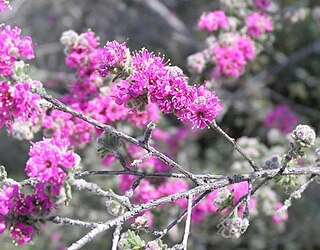
Kunzea preissiana is a flowering plant in the myrtle family, Myrtaceae, and is endemic to the southwest of Western Australia. It is a shrub with hairy branches and leaves, pink to mauve flowers in groups on the ends of shoots, and twenty to thirty stamens about the same length as the petals. It is a widespread, often locally common species across its range.
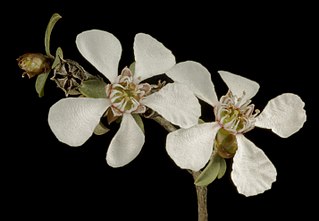
Leptospermum erubescens, commonly known as the roadside tea tree, is a species of shrub that is endemic to southwest of Western Australia. It has thin, fibrous bark, egg-shaped leaves, small white flowers and woody fruit.



















